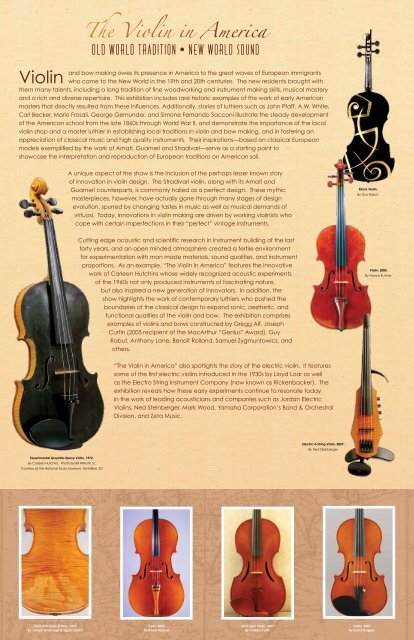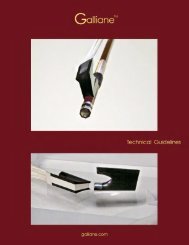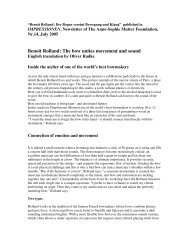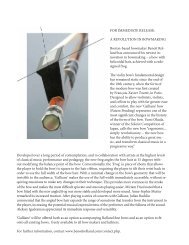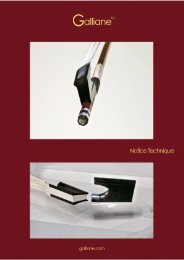The Violin in America - Benoît Rolland
The Violin in America - Benoît Rolland
The Violin in America - Benoît Rolland
Create successful ePaper yourself
Turn your PDF publications into a flip-book with our unique Google optimized e-Paper software.
<strong>Viol<strong>in</strong></strong><br />
<strong>The</strong> <strong>Viol<strong>in</strong></strong> <strong>in</strong> <strong>America</strong><br />
Old World Tradition • New World Sound<br />
and bow mak<strong>in</strong>g owes its presence <strong>in</strong> <strong>America</strong> to the great waves of European immigrants<br />
who came to the New World <strong>in</strong> the 19th and 20th centuries. <strong>The</strong> new residents brought with<br />
them many talents, <strong>in</strong>clud<strong>in</strong>g a long tradition of f<strong>in</strong>e woodwork<strong>in</strong>g and <strong>in</strong>strument mak<strong>in</strong>g skills, musical mastery<br />
and a rich and diverse repertoire. This exhibition <strong>in</strong>cludes rare historic examples of the work of early <strong>America</strong>n<br />
masters that directly resulted from these <strong>in</strong>fluences. Additionally, stories of luthiers such as John Pfaff, A.W. White,<br />
Carl Becker, Mario Frosali, George Gemunder, and Simone Fernando Sacconi illustrate the steady development<br />
of the <strong>America</strong>n school from the late 1860s through World War II, and demonstrate the importance of the local<br />
viol<strong>in</strong> shop and a master luthier <strong>in</strong> establish<strong>in</strong>g local traditions <strong>in</strong> viol<strong>in</strong> and bow mak<strong>in</strong>g, and <strong>in</strong> foster<strong>in</strong>g an<br />
appreciation of classical music and high quality <strong>in</strong>struments. <strong>The</strong>ir <strong>in</strong>spirations—based on classical European<br />
models exemplified by the work of Amati, Guarneri and Stradivari—serve as a start<strong>in</strong>g po<strong>in</strong>t to<br />
showcase the <strong>in</strong>terpretation and reproduction of European traditions on <strong>America</strong>n soil.<br />
A unique aspect of the show is the <strong>in</strong>clusion of the perhaps lesser known story<br />
of <strong>in</strong>novation <strong>in</strong> viol<strong>in</strong> design. <strong>The</strong> Stradivari viol<strong>in</strong>, along with its Amati and<br />
Guarneri counterparts, is commonly hailed as a perfect design. <strong>The</strong>se mythic<br />
masterpieces, however, have actually gone through many stages of design<br />
evolution, spurred by chang<strong>in</strong>g tastes <strong>in</strong> music as well as musical demands of<br />
virtuosi. Today, <strong>in</strong>novations <strong>in</strong> viol<strong>in</strong> mak<strong>in</strong>g are driven by work<strong>in</strong>g viol<strong>in</strong>ists who<br />
cope with certa<strong>in</strong> imperfections <strong>in</strong> their “perfect” v<strong>in</strong>tage <strong>in</strong>struments.<br />
Black <strong>Viol<strong>in</strong></strong>.<br />
By Guy Rabut.<br />
Cutt<strong>in</strong>g edge acoustic and scientific research <strong>in</strong> <strong>in</strong>strument build<strong>in</strong>g of the last<br />
forty years, and an open m<strong>in</strong>ded atmosphere created a fertile environment<br />
for experimentation with man made materials, sound qualities, and <strong>in</strong>strument<br />
proportions. As an example, “<strong>The</strong> <strong>Viol<strong>in</strong></strong> <strong>in</strong> <strong>America</strong>” features the <strong>in</strong>novative<br />
work of Carleen Hutch<strong>in</strong>s whose widely recognized acoustic experiments<br />
of the 1960s not only produced <strong>in</strong>struments of fasc<strong>in</strong>at<strong>in</strong>g nature,<br />
but also <strong>in</strong>spired a new generation of <strong>in</strong>novators. In addition, the<br />
show highlights the work of contemporary luthiers who pushed the<br />
boundaries of the classical design to expand sonic, aesthetic, and<br />
functional qualities of the viol<strong>in</strong> and bow. <strong>The</strong> exhibition comprises<br />
examples of viol<strong>in</strong>s and bows constructed by Gregg Alf, Joseph<br />
Curt<strong>in</strong> (2005 recipient of the MacArthur “Genius” Award), Guy<br />
Rabut, Anthony Lane, Benoît <strong>Rolland</strong>, Samuel Zygmuntowicz, and<br />
others.<br />
<strong>Viol<strong>in</strong></strong>, 2005.<br />
By Francis Kuttner.<br />
“<strong>The</strong> <strong>Viol<strong>in</strong></strong> <strong>in</strong> <strong>America</strong>” also spotlights the story of the electric viol<strong>in</strong>. It features<br />
some of the first electric viol<strong>in</strong>s <strong>in</strong>troduced <strong>in</strong> the 1930s by Lloyd Loar as well<br />
as the Electro Str<strong>in</strong>g Instrument Company (now known as Rickenbacker). <strong>The</strong><br />
exhibition reveals how these early experiments cont<strong>in</strong>ue to resonate today<br />
<strong>in</strong> the work of lead<strong>in</strong>g acousticians and companies such as Jordan Electric<br />
<strong>Viol<strong>in</strong></strong>s, Ned Ste<strong>in</strong>berger, Mark Wood, Yamaha Corporation’s Band & Orchestral<br />
Division, and Zeta Music.<br />
Electric 4-Str<strong>in</strong>g <strong>Viol<strong>in</strong></strong>, 2007.<br />
By Ned Ste<strong>in</strong>berger.<br />
Experimental Graphite-Epoxy <strong>Viol<strong>in</strong></strong>, 1972.<br />
By Carleen Hutch<strong>in</strong>s. Photo by Bill Willroth, Sr.<br />
Courtesy of the National Music Museum, Vermillion, SD<br />
Viola with map of Italy, 1992<br />
By Joseph Grubaugh & Sigrun Seifert<br />
Cello, 2002<br />
By David Folland<br />
Ultra-light <strong>Viol<strong>in</strong></strong>, 2007<br />
By Joseph Curt<strong>in</strong><br />
<strong>Viol<strong>in</strong></strong>, 2007<br />
By David Burgess


